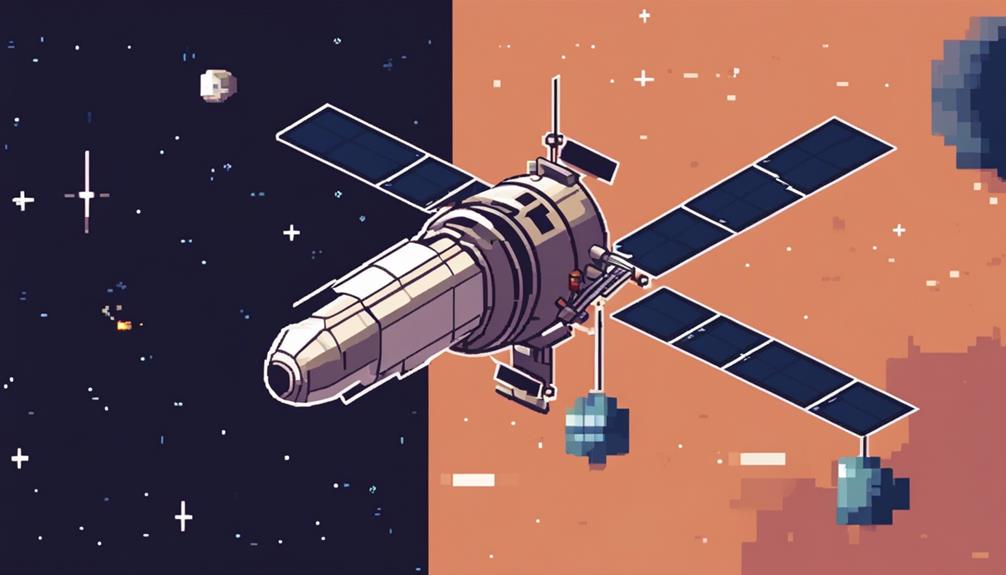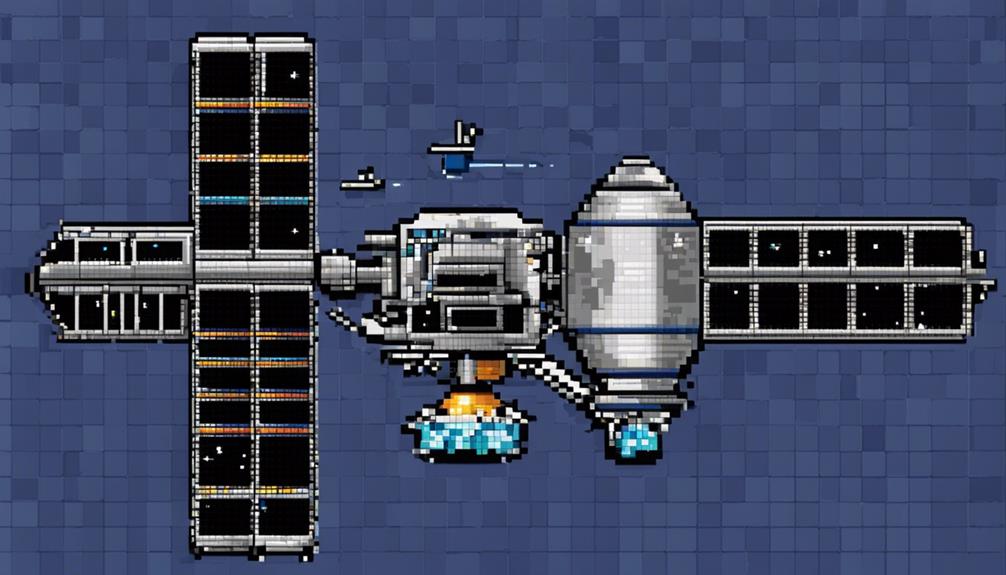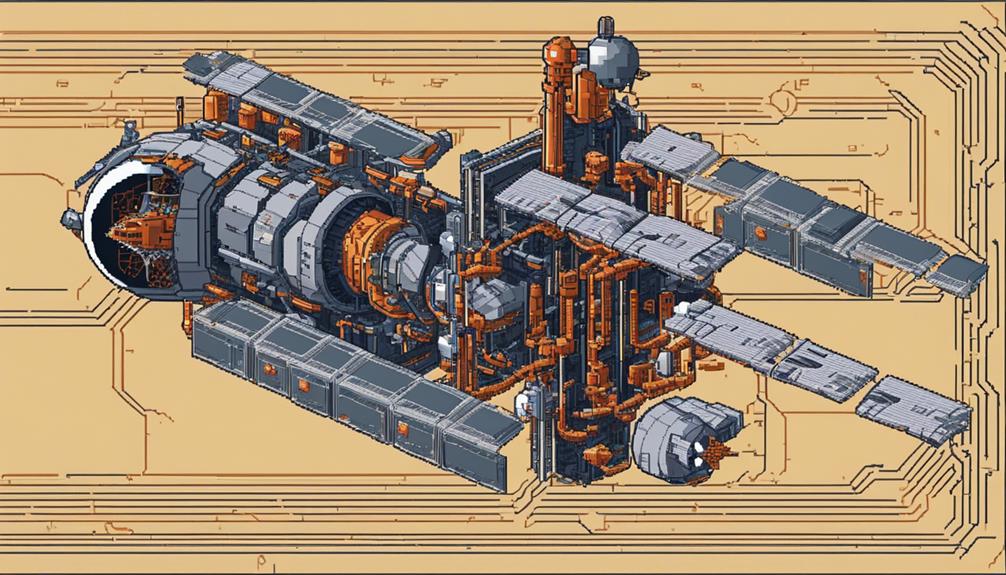Satellite propulsion systems represent the intricate engineering marvels that enable precise control and navigation of spacecraft in the vastness of space. From traditional bipropellant systems to cutting-edge electric ion propulsion technologies, the evolution of these propulsion systems has revolutionized space exploration capabilities. But what challenges do engineers face in designing and implementing these propulsion systems? The complexities hidden behind the thrust and efficiency of these systems offer a fascinating glimpse into the future of satellite propulsion.
Key Takeaways
- Hydrazine propulsion commonly used for satellite maneuvering.
- Ion Propulsion offers extended mission capabilities.
- Efficient propellant mixtures crucial for optimal performance.
- Diverse propulsion systems cater to various spacecraft requirements.
Chemical Rocket Propulsion

Chemical rocket propulsion is a fundamental propulsion method utilized in spacecraft engineering to achieve high-thrust maneuvers through the controlled chemical reactions of propellants. In the realm of satellite propulsion, chemical propulsion systems play a crucial role in enabling rapid changes in velocity and precise maneuvers necessary for satellite operations. One common type of chemical propulsion system used in satellites is the hydrazine propulsion system. Hydrazine-based systems are favored for their simplicity, storability, and reliability, making them a popular choice for satellite propulsion applications.
Satellite propulsion systems rely on chemical rocket propulsion due to the need for quick acceleration and deceleration in the vacuum of space. These systems are essential for adjusting the orbit, orientation, and position of satellites for various purposes such as communication, Earth observation, and scientific research. The versatility and efficiency of chemical propulsion systems make them a preferred choice for satellite missions requiring high-thrust maneuvers.
In addition to hydrazine propulsion systems, satellite propulsion encompasses a variety of chemical rocket propulsion technologies, including mono/bipropellant systems, hybrids, cold/warm gas systems, and solid propellants. Each of these variations offers unique advantages and trade-offs in terms of performance, complexity, and specific mission requirements. Overall, chemical rocket propulsion remains a cornerstone of satellite propulsion systems, enabling the precise control and maneuverability necessary for successful satellite operations in space.
Bipropellant Systems
Bipropellant systems in satellite propulsion are known for their efficiency and reliance on specific propellant mixture ratios to achieve optimal performance. The careful balance and management of fuel and oxidizer combinations play a crucial role in the functionality and effectiveness of these propulsion systems. Understanding the interplay between propellants and their ratios is essential for maximizing thrust and ensuring precise maneuvering capabilities in space missions.
Efficiency of Bipropellants
The efficiency of bipropellant systems in satellite propulsion is notably enhanced through the utilization of both fuel and oxidizer tanks for optimal performance. This setup allows for a more controlled combustion process, leading to higher thrust levels and specific impulse. Key components like thrusters, fuel and oxidizer tanks, and valves work in unison to ensure precise operation and maneuverability. The integration of a Unified Propulsion System (UPS) further refines the system, enhancing its overall performance and reliability. Bipropellant systems are crucial for orbital maneuvers and spacecraft control in a wide range of missions, making them a cornerstone in satellite propulsion technology.
- Controlled combustion process
- Higher thrust levels and specific impulse
- Unified Propulsion System (UPS) integration
Propellant Mixture Ratios
Efficient operation and optimal performance of satellite propulsion systems heavily rely on the precise calibration of propellant mixture ratios in bipropellant systems. Bipropellant systems combine fuel and oxidizer in specific ratios crucial for propulsion efficiency. These ratios play a critical role in achieving controlled combustion, maximum thrust, and overall system efficiency. Engineers meticulously calculate and adjust these mixture ratios to meet mission requirements and enhance thruster performance. By determining the optimal propellant mixture ratios, satellite propulsion systems can operate at peak levels, ensuring the successful execution of various space missions. The careful consideration and adjustment of propellant mixture ratios are fundamental in achieving the desired performance levels and mission objectives in bipropellant propulsion systems.
Monopropellant Systems

Monopropellant systems, known for their simplicity and reliability, are frequently employed for small to medium spacecraft missions, particularly in Low Earth Orbit (LEO) and Medium Earth Orbit (MEO). These propulsion systems offer a range of benefits tailored to spacecraft propulsion needs.
- Efficiency: Monopropellant systems provide efficient propulsion technology for satellites operating in LEO and MEO. Their simplicity makes them ideal for missions where reliability is crucial.
- Customization: These systems offer custom modules tailored to satellites within specific weight classes, ensuring optimal performance for each mission's unique requirements.
- Component Integration: Monopropellant systems include standard off-the-shelf components like Roll and Attitude Control Systems (RACS). This integration enhances the overall functionality of the propulsion system.
Monopropellant systems are also utilized for heavy and small launchers to ensure precise control and stabilization during missions. Their design and operation contribute to the successful execution of various space missions, emphasizing the importance of reliable and efficient propulsion technologies in the realm of spacecraft operations.
Hall Effect Thrusters
Hall Effect Thrusters, renowned for their utilization of electric fields to accelerate ions for spacecraft propulsion, represent a significant advancement in propulsion technology. These ion thrusters operate by ionizing propellant gas, such as xenon, and then using electric fields to accelerate the ions to generate thrust. They offer high specific impulse, typically around 1500-3000 seconds, making them highly efficient for long-duration missions. Hall Effect Thrusters are commonly utilized for station-keeping, orbit-raising, and attitude control on various satellites and spacecraft due to their reliability and performance.
Hall Effect Thrusters Overview
| Feature | Description |
|---|---|
| Propulsion System | Electric propulsion |
| Thrust Mechanism | Ion thruster |
| Application | Spacecraft propulsion |
These thrusters have been integral to the success of numerous commercial, scientific, and military spacecraft missions. Their ability to provide thrust efficiently over long periods makes them ideal for various space operations. Hall Effect Thrusters continue to be a vital component in the field of spacecraft propulsion, showcasing the advancements achieved in electric propulsion systems.
Ion Propulsion Technology

Ion Propulsion Technology, known for its unparalleled efficiency and extended mission capabilities, revolutionizes spacecraft propulsion through its high specific impulse and continuous thrust capabilities.
- Ion propulsion technology offers a specific impulse 10-20 times higher than liquid propellant engines, significantly enhancing the efficiency of spacecraft propulsion systems.
- With increasing electric power availability, ion propulsion systems exhibit high growth potential, making them the preferred choice for long-duration interplanetary missions.
- Advantages of ion propulsion include reduced mass, longer mission durations, and increased payload capacity, positioning them as a promising technology for the future of space exploration.
Ion propulsion technology plays a crucial role in advancing space exploration by providing high precision spacecraft control and continuous thrust over extended periods. As electric power sources continue to improve, ion propulsion systems are becoming increasingly attractive for various mission profiles due to their superior specific impulse and maneuverability capabilities. The efficiency and performance benefits offered by ion propulsion technology make it a key advancement in spacecraft propulsion, paving the way for enhanced capabilities and opportunities in the realm of space exploration.
Gridded Ion Thrusters
Gridded ion thrusters excel in efficient ion acceleration by utilizing precisely designed grids to accelerate ions, resulting in high specific impulse and fuel efficiency. The advantages of their grid design contribute to their low propellant consumption rates, making them highly suitable for extended space missions. These features enable gridded ion thrusters to provide continuous low thrust for precise spacecraft control and adjustments in trajectory and orientation.
Efficient Ion Acceleration
Utilizing electrostatic fields to accelerate ions for propulsion in satellites, efficient ion acceleration systems play a crucial role in achieving high-specific impulse for long-duration missions. Gridded ion thrusters offer precise spacecraft control, making them essential for various orbital maneuvers. They are known for their low propellant consumption, making them ideal for extended missions where efficiency is paramount. Gridded ion thrusters excel in providing high specific impulse by accelerating ions to high velocities, enabling satellites to achieve necessary velocity changes while conserving propellant. These thrusters are commonly utilized in geostationary satellites for tasks like station-keeping and orbit adjustments, showcasing their versatility and reliability in space operations.
Grid Design Advantages
How does the grid design of ion thrusters contribute to the efficiency and precision of satellite propulsion systems? Gridded ion thrusters are designed with a grid system that allows for precise thrust control, enabling spacecraft to make subtle adjustments with accuracy. This design feature plays a crucial role in optimizing the specific impulse of the thrusters, resulting in efficient use of propellant and extended mission durations. By adjusting the grid, operators can tailor the thrust levels to meet the requirements of different maneuvers, making gridded ion thrusters ideal for various satellite operations. The table below further highlights the advantages of grid design in ion thrusters:
| Grid Design Advantages | |
|---|---|
| Precise Thrust Control | Achieve accurate adjustments |
| High Specific Impulse | Efficient propellant use |
| Adjustable Thrust Levels | Optimize spacecraft maneuvers |
| Long-Duration Missions | Ideal for extended operations |
Propellant Consumption Rates
The propellant consumption rates of gridded ion thrusters are directly influenced by factors such as thrust level and specific impulse values, impacting operational longevity and mission duration.
- Gridded ion thrusters consume propellant at rates ranging from 10-300 micrograms per second.
- Propellant consumption rates vary based on thrust level and specific impulse of the ion thruster.
- Higher thrust levels and specific impulse values result in increased propellant consumption rates.
Efficient propellant management is crucial for maximizing the performance and longevity of ion thrusters in space missions. Careful consideration of these consumption rates is essential to ensure the successful completion of extended missions while maintaining operational efficiency.
Pulsed Plasma Thrusters
Pulsed Plasma Thrusters (PPTs) are advanced electric propulsion systems that leverage pulsed discharges of high-energy plasma to generate thrust efficiently for space missions. These thrusters are highly regarded for their high specific impulse, enabling effective propulsion in the vacuum of space. PPTs play a crucial role in attitude control, orbit adjustments, and small velocity changes required for precise satellite maneuvers.
One of the key advantages of PPTs is their suitability for small spacecraft applications due to their compact size, lightweight design, and low power consumption. These features make them ideal for missions where space and weight are limited factors. Additionally, the precise control over thrust levels offered by the pulsed operation of PPTs enhances the maneuverability of spacecraft, allowing for intricate orbital adjustments and attitude control.
Magnetoplasmadynamic Thrusters

Magnetoplasmadynamic thrusters are characterized by their utilization of superheated plasma to generate thrust through the ionization and acceleration of gas employing magnetic fields. The precise control of magnetic fields in these thrusters enables efficient plasma acceleration, resulting in high specific impulse for propulsion applications. Researchers are actively exploring various thrust optimization techniques to further enhance the performance of magnetoplasmadynamic thrusters for advanced space missions.
Efficient Plasma Acceleration
Utilizing magnetic fields and electrical currents, plasma acceleration in advanced propulsion systems achieves unparalleled efficiency and high specific impulse. Magnetoplasmadynamic thrusters, a type of electric propulsion system, exemplify this technology by harnessing these principles to propel spacecraft. Key points to consider about efficient plasma acceleration in magnetoplasmadynamic thrusters include:
- High specific impulse and efficiency: These thrusters offer superior performance compared to conventional propulsion methods.
- Acceleration capabilities: Plasma acceleration in these thrusters can achieve exhaust velocities of up to 100 km/s.
- Potential applications: Research is ongoing for utilizing this technology in deep space missions and satellite propulsion, highlighting its versatility and promise for the future of space exploration.
Magnetic Field Control
Controlled manipulation of magnetic fields is a fundamental aspect of optimizing the performance and efficiency of magnetoplasmadynamic thrusters in spacecraft propulsion systems. These thrusters use electromagnetic forces to accelerate plasma, achieving high specific impulse and continuous thrust for long-duration missions. Research into magnetoplasmadynamic thrusters is driven by their potential for future deep-space exploration missions. The precise control enabled by magnetic field manipulation enhances maneuverability in space environments.
| Magnetic Field Control | Benefits |
|---|---|
| High Specific Impulse | Efficient propulsion |
| Precise Maneuverability | Enhanced control |
| Extended Thrust Duration | Suitable for long missions |
| Future Space Exploration | Advancing space propulsion |
Thrust Optimization Techniques
Optimizing the thrust efficiency of magnetoplasmadynamic thrusters in satellite propulsion systems involves implementing advanced techniques to enhance performance and maneuverability in space missions. These high-specific impulse thrusters offer superior efficiency and are ideal for long-duration missions and deep space exploration. To achieve optimal performance, several thrust optimization techniques are employed:
- Utilizing advanced magnetic field control mechanisms to enhance thrust precision.
- Implementing innovative propellant ionization processes for increased propulsion efficiency.
- Fine-tuning the acceleration of propellant gases to maximize thrust output and maneuvering capabilities.
Research and development efforts continue to focus on refining these techniques to further improve the functionality and performance of magnetoplasmadynamic thrusters in satellite propulsion systems.
Field Emission Electric Propulsion

Field Emission Electric Propulsion (FEEP) systems revolutionize satellite propulsion through the utilization of electrostatic forces to emit and accelerate liquid metal ions for highly efficient and precise thrust control. FEEP thrusters offer a high specific impulse, exceeding 10,000 seconds, making them ideal for small satellites and deep space missions requiring long-duration maneuvers. These systems enable fine attitude control and orbit adjustments with minimal propellant consumption, enhancing spacecraft maneuverability in missions where precision is critical.
—
| Advantages of FEEP Systems | Description |
|---|---|
| High Specific Impulse | Specific impulse values exceeding 10,000 seconds for efficient propulsion. |
| Precise Thrust Control | Enables accurate thrust adjustments, crucial for small satellite operations. |
| Long Operational Lifetimes | Low erosion rates and high reliability support extended mission durations. |
| Minimal Propellant Consumption | Efficient utilization of propellant for prolonged deep space missions. |
—
FEEP technology's ability to provide long-lasting, precise thrust makes it a preferred choice for missions requiring continuous and accurate propulsion. The high specific impulse values of FEEP systems ensure that small satellites can reach their destinations effectively, even in deep space environments where conventional propulsion systems may fall short.
Electrothermal Systems
How do electrothermal propulsion systems utilize electrical energy to generate high-velocity exhaust gases for thrust in space missions? Electrothermal propulsion systems operate by heating a propellant using electrical energy to produce high-speed exhaust that generates thrust. This method provides a means of propulsion that is efficient and reliable for various space missions. Here are some key points about electrothermal propulsion systems:
- Efficient Propulsion: Electrothermal propulsion systems, such as resistojet thrusters, are known for their high specific impulse. This efficiency allows them to provide a greater change in momentum per unit of propellant compared to other propulsion systems.
- Resistojet Thrusters: These thrusters are a type of electrothermal propulsion system that uses a resistive heating element to heat the propellant before expelling it at high speeds to generate thrust. Resistojet thrusters are commonly used for orbit insertion and station-keeping maneuvers due to their precise control capabilities.
- Versatile Propellant Options: Electrothermal systems can operate using various propellants, including water and ammonia. This versatility in propellant options gives these systems the flexibility to be used in different mission scenarios while maintaining high performance.
Electrothermal propulsion systems play a crucial role in satellite propulsion, offering high efficiency and precise control for a wide range of space missions. Ongoing advancements in electrothermal technology continue to enhance the performance and capabilities of these propulsion systems in space exploration.
Colloid Thrusters

Colloid thrusters, as micropropulsion systems utilizing electric fields to expel charged droplets of conductive liquid propellant, play a pivotal role in providing high efficiency and precise control for small satellite missions. These thrusters operate based on the principle of electrohydrodynamics, where the acceleration and expulsion of charged droplets generate thrust. By leveraging electric fields, colloid thrusters offer a significant advantage in propulsion efficiency and control compared to traditional systems.
The use of charged droplets as propellant enables colloid thrusters to achieve precise attitude adjustments and orbit maintenance in small satellites with low power consumption. Their high efficiency and precise control make them ideal for applications requiring fine maneuvers and versatility in propulsion capabilities. Colloid thrusters have demonstrated potential in various spacecraft maneuvers, drag compensation, and formation flying tasks, showcasing their adaptability and reliability in the realm of small satellite missions.
Solar Sail Propulsion
Having explored the efficiency and precise control of colloid thrusters in small satellite missions, the focus now shifts to solar sail propulsion, a technology that harnesses sunlight for continuous thrust in space exploration. Solar sail propulsion utilizes large reflective sails to capture and reflect sunlight for propulsion in space. The force generated by sunlight on the sail allows spacecraft to accelerate and change direction without traditional fuel. This technology offers a continuous thrust without the need for propellant, enabling long-duration missions.
Key Points:
- Solar sail propulsion harnesses sunlight for continuous thrust in space.
- It offers a fuel-free propulsion method for spacecraft.
- Ideal for interplanetary missions where sunlight is abundant.
Solar sail propulsion is particularly advantageous for interplanetary missions where sunlight is plentiful and can provide a constant source of propulsion. By eliminating the need for traditional propellants, solar sail technology opens up new possibilities for extended missions beyond Earth's orbit. Successful demonstrations of solar sail propulsion in various space missions have highlighted its potential as a viable propulsion system for future spacecraft, especially in scenarios requiring extended operation in space. The continuous thrust provided by solar sails can significantly enhance the efficiency and range of interplanetary missions, making them a promising technology for the future of space exploration.
Nuclear Thermal Rocket Systems

Nuclear thermal rocket systems utilize nuclear reactions to heat a propellant, typically hydrogen, to generate high thrust and specific impulse for deep space missions. These advanced propulsion systems offer significantly higher efficiency and faster speeds compared to traditional chemical rockets, making them essential for enabling quicker interplanetary travel and supporting human exploration beyond Earth's orbit. Extensively studied for decades, nuclear thermal rocket systems have the potential to revolutionize our ability to explore the solar system by providing the necessary propulsion for long-duration missions to distant celestial bodies.
The development of nuclear thermal propulsion technology is focused on overcoming the limitations of conventional chemical propulsion systems, particularly in terms of efficiency and thrust capabilities required for extended space travel. Ongoing research and development efforts aim to enhance the performance and safety of nuclear thermal rocket systems, ensuring their viability for future crewed missions to Mars, the Moon, and potentially even more distant destinations. By harnessing the power of nuclear reactions to propel spacecraft through the vastness of space, these systems represent a critical step forward in advancing human presence and exploration beyond Earth's immediate surroundings.
Frequently Asked Questions
What Are the Propulsion Systems in Satellites?
Future technologies in satellite propulsion systems are advancing rapidly. Electric propulsion, including ion thrusters, is gaining popularity due to its high specific impulse and precise control. Solar sails are also an emerging technology that offers sustainable propulsion using sunlight. Propellant options are diverse, ranging from traditional bipropellant systems to innovative electric propulsion. Thrust capabilities vary depending on the propulsion system, with electric propulsion offering continuous thrust and potential for growth.
What Are the 4 Main Propulsion Systems?
Electric propulsion and chemical propulsion are two main categories of satellite propulsion systems. Electric propulsion, such as ion thrusters, offers high efficiency and precise control for satellite maneuverability. On the other hand, chemical propulsion systems provide higher thrust levels, aiding in satellite positioning and thrust vectoring. By combining these technologies, satellites achieve a balance between propulsion efficiency and performance, ensuring optimal functionality for various missions in space.
Why Do Satellites Need Propulsion Systems?
Propulsion systems are vital for satellites due to their crucial role in ensuring efficiency benefits, cost savings, and maneuverability control. These systems enable precise spacecraft acceleration and movement in space, allowing for orbital adjustments, collision avoidance, and optimal performance. By utilizing propulsion systems, satellites can maintain trajectory, position, and maneuver during critical mission phases like orbit transfers and deorbiting, enhancing overall operational capabilities and mission success.
What Is the Propulsion Subsystem of a Satellite?
The propulsion subsystem of a satellite is a critical component responsible for managing thrust control and efficiency optimization to ensure precise movement and positioning in space. It enhances maneuverability while considering fuel consumption for optimal performance. This subsystem can utilize various propulsion systems such as electric propulsion or chemical propulsion to achieve the desired trajectory and mission objectives. It consists of components like thrusters, valves, control systems, and fuel tanks to support satellite operations effectively.

